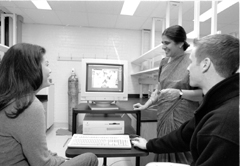The University Record, November 1, 1999 Editor’s Note: This article is one in a series on U-M projects that have been recognized by the Computerworld Smithsonian Program, announced in a Sept. 27 article that can be found on the Web at
By Theresa Maddix

“This is exactly what you would see under the microscope,” said Mike Schaefer, while looking at a computer screen with fruit flies randomly spread across it. “It even makes sounds like you would hear in the real lab,” said Karen Kobayashi, listening to the program’s “whoosh” as the anesthetic is released. Kobayashi and Schaefer, fourth-year students in Biology 306: Genetics Laboratory Course, were responding to the Genetics Virtual Fly Lab (CyberFly) on a Macintosh computer.
The fly experiment, using common fruit flies, is an independent project involving various fly crosses taken through two generations. Data collection and analysis lead to the location of mutant genes on different chromosomes. The lab is a classic genetics experiment and one Santhadevi Jeyabalan, lecturer in biology, has done with students for many years.
“This experiment used to occupy six, seven weeks,” Jeyabalen says. “We would start a different project after this one was under way.” Even as students were doing their other projects on roundworms, bacteria and yeast, a significant part of their lab time was still devoted to the fruit fly experiment.
Then Jeyabalan found another experiment using molecular techniques that she wanted to include in the course, and was faced with eliminating one of the existing projects. Instead she found a new solution—creating her own CyberFly computer program. Students still begin the fruit fly experiment with real fruit flies and complete a portion of it in the lab, but the rest is done using the CyberFly simulation in the Science Learning Center. The project can now be completed in three to four weeks time.
To create the program, Jeyabalan worked with ITD technologists Roger Espinosa and Steve Burdick, “two excellent programmers” who tried “to really do the lab as exactly as possible.” Jeyabalan says that even though their backgrounds are not in genetics they dove right in and tried to learn all they could about how the experiment is done. The program’s verisimilitude is a credit to their work, she says. Not only does the program have the look and sound of the actual experiment, in many ways it has the feel. Students can zoom in and out like they do when using a microscope, and can click on the flies with the mouse to move them around to collect color and feature data.
The program doesn’t give any “answers” to the students, and “if they come up with something different than expected, we don’t penalize them,” Jeyabalan says. “Data collection and analysis is the important aspect of this experiment.”
No other program for crossing fruit flies exists with such sophistication. Online labs with fruit flies are available, but after the flies “mate” the computer provides the data for the variables in the progeny. The numbers appear, not from student collection but as if by magic.
Jeyabalan is working on adapting her program to introductory biology. The design is different—there are fewer variables to search for with each fly—but the concepts are the same. At this stage, funding for the project remains a hurdle. The original CyberFly project was funded with a grant from the LS&A Instructional Technology Grant Program.
In the future, Jeyabalan hopes to harness young students’ love of “playing on the computer” to get high schoolers “excited about genetics.” She wants to prepare a modified version of the CyberFly program for K–12 education that allows students “to choose what they want” as variables.

